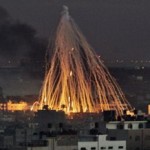by Adrienne Mayor (Wonder & Marvels contributor)
In 332 BC Alexander the Great and his Macedonian army suffered the effects of a fiendish chemical incendiary that caused horrendous casualties. During Alexander’s seven-month siege of the Phoenician city of Tyre (now Lebanon), the Phoenicians realized that they needed a powerful antipersonnel weapon to “conquer such a courageous enemy.” They devised “an ingenious and horrible torment which even the bravest could not deflect.” The ancient Greek historian Diodorus described the battle.
The Phoenicians heated fine sand in enormous shallow bronze bowls. Then they either poured or catapulted the red-hot sand over Alexander’s soldiers. The sand rained down on “those who were fighting most boldly, bringing them utter misery.” There was no escape for anyone within range, says Diodorus, as the molten grains of sand “sifted down” on the Macedonians, “searing their skin with intense heat, inflicting terrible pain.” Diodorus tells how the victims writhed, trying to shake off the sand, “shrieking like those under torture.” In “excruciating agony,” Diodorus continued, many of Alexander’s men “went mad and died.”
The account of the rain of burning sand at Tyre, created two millennia ago, bears an uncanny resemblance to the effects of a modern chemical incendiary, white phosphorus. Like the burning grains of sand deployed by the Phoenicians, the hot metallic embers of white phosphorus cause clothing and other materials to combust. When white phosphorus bombshells burst, the explosion showers white-hot shrapnel that sticks to the skin and burns through flesh to the bone, causing severe deep burns or death. Wounds continue to smolder even after dressings are applied. Much like the Phoenicians’ heated sand, the tiny intensely hot flakes of phosphorus continue to burn as they penetrate deeply through skin and flesh, causing severe burns or death.
White phosphorus clearly has all of the horrific features of a chemical weapon. It is widely dispersed with no means of precise delivery to targets, inevitably blanketing civilians within range, causing extreme suffering to anyone it touches. Currently, white phosphorus is not classified or banned as a chemical weapon. It seems that history’s lessons should be enough to convince us that no government can justify deploying chemical armaments or any substance that behaves like one. Yet numerous reports allege that white phosphorus antipersonnel weapons have been used in the past few decades in the Middle East and Central Asia (Iraq, Libya, Yemen, Chechen, Afghanistan, Lebanon, and Gaza). Such claims are usually denied, with rationalizations that the phosphorus is used only for nighttime illumination or to create dense smoke cover for advancing troops.
Chemical weapons are generally assumed to be modern inventions, but their roots are very ancient. It is sadly ironic that an ancient precursor to phosphorus incendiaries was reported more than two millennia ago in this same historically war-torn corner of the world.
About the author: Adrienne Mayor is a Research Scholar in Classics and History of Science, Stanford University. She is the author of “Greek Fire, Poison Arrows, & Scorpion Bombs: Biological and Chemical Warfare in the Ancient World” (2009); and “The Poison King: The Life and Legend of Mithradates, Rome’s Deadliest Enemy,” a nonfiction finalist for the 2009 National Book Award.
